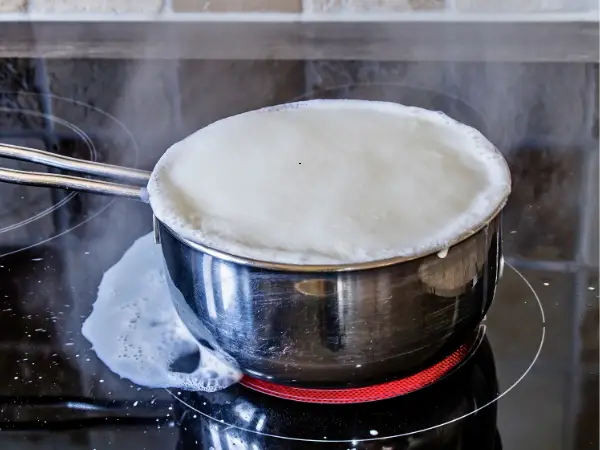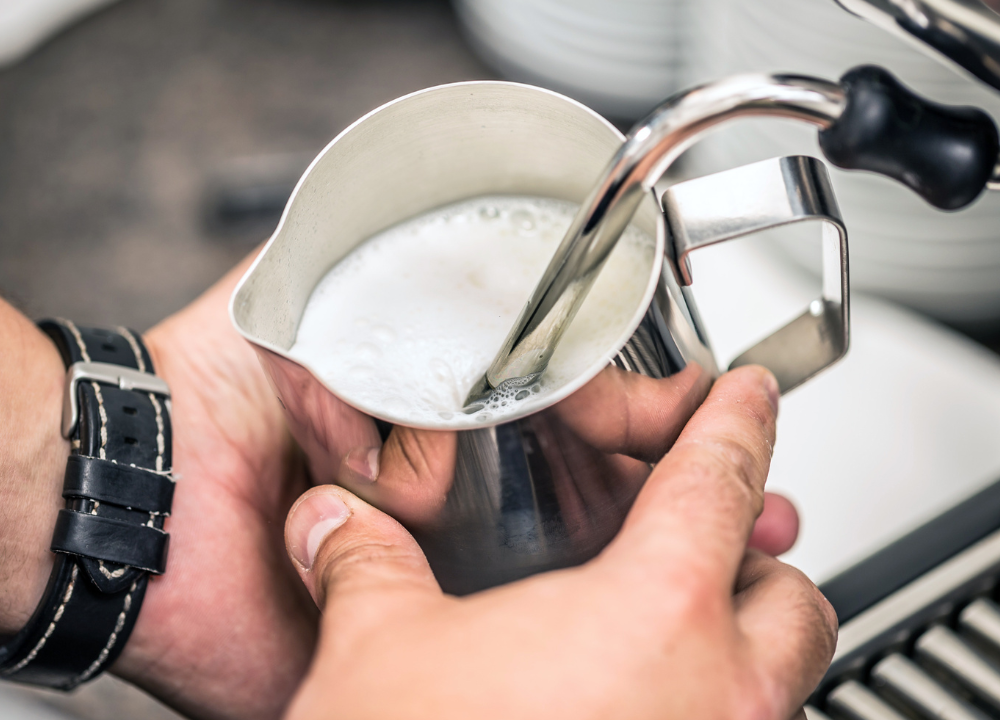Understanding the differences between steamed and frothed milk will help you decide which suits your taste. This guide will explore both options and help you find the best choice for your next cup of coffee.
The Great Debate – Steamed Milk Vs. Frothed Milk
Should you choose steamed milk or frothed milk? Each option offers a unique taste and texture. Understanding their differences can help you enjoy your coffee more.
Understanding The Basics Of Steamed And Frothed Milk
Steamed milk and frothed milk are two popular choices for coffee drinks. They both start with the same ingredient: milk. However, the way they are prepared makes them different.
- Steamed Milk: This milk is heated and mixed with steam. It becomes creamy and smooth. It has a velvety texture.
- Frothed Milk: This milk is whipped to create bubbles. It is light and airy. It has a foam-like texture.
Here is a quick comparison of the two:
| Feature | Steamed Milk | Frothed Milk |
|---|---|---|
| Texture | Creamy and smooth | Light and airy |
| Temperature | Hot | Warm or cool |
| Use | Lattes, cappuccinos | Cappuccinos, macchiatos |
Both types of milk can enhance your coffee experience. Choosing one depends on your taste and the drink you prefer.
Why The Milk Texture Matters For Your Coffee
The texture of milk changes the way your coffee tastes. It also affects how the drink feels in your mouth. Each texture brings out different flavors. Here’s why it matters:
- Flavor Release: Creamy steamed milk blends well with coffee. It can mellow strong flavors.
- Visual Appeal: Froth adds a beautiful layer on top. It makes the drink look inviting.
- Mouthfeel: Smooth milk feels different than frothy milk. Your choice can change your enjoyment.
Think about the following:
- Do you like rich, creamy flavors?
- Or do you prefer something light and airy?
Your answer will guide your choice between steamed and frothed milk. Experiment with both to find your favorite.

What Is Steamed Milk?
Steamed milk is milk heated with steam to create a creamy texture. It adds sweetness and richness to coffee drinks.
The Steaming Process: How It Affects Texture And Taste
The steaming process involves heating milk using steam from an espresso machine. This technique not only warms the milk but also adds air. The result is a velvety texture and a slightly sweet flavor.
Here’s how the steaming process affects your coffee:
- Texture: Steamed milk is creamy and smooth.
- Flavor: Heating milk brings out natural sugars, enhancing sweetness.
- Temperature: Ideal for warming your coffee without scalding.
- Stability: Great for latte art due to its silky foam.
Steamed milk has a different density than cold milk. This makes it ideal for mixing with espresso. Here’s a quick comparison of steamed milk and other milk types:
| Milk Type | Texture | Flavor |
|---|---|---|
| Steamed Milk | Creamy | Sweet |
| Frothed Milk | Light and airy | Less sweet |
This unique process results in a rich experience that many coffee lovers enjoy. The smoothness of steamed milk pairs well with espresso, balancing bitterness with sweetness.
Best Coffee Drinks For Steamed Milk
Steamed milk enhances many coffee drinks. Here are the best ones that highlight its creamy texture:
- Latte: A classic choice, made with espresso and steamed milk.
- Cappuccino: Equal parts espresso, steamed milk, and frothed milk.
- Macchiato: A shot of espresso topped with a small amount of steamed milk.
- Flat White: Similar to a latte but with a higher ratio of coffee to milk.
Each drink offers a unique experience:
- Latte: Smooth and creamy.
- Cappuccino: Rich with a frothy top.
- Macchiato: Bold with a hint of milk.
- Flat White: Strong coffee flavor with creamy milk.
Try these drinks to appreciate the rich texture of steamed milk. They provide warmth and comfort, perfect for any coffee lover.

What Is Frothed Milk?
Frothed milk adds a unique texture and richness to various drinks. It is milk that has been aerated to create a light, airy foam. This foam sits on top of your coffee, enhancing both flavor and appearance.
The Frothing Process: Creating A Creamy Texture
The frothing process involves adding air to milk, making it light and fluffy. This is done using a frothing wand or a steam wand. The goal is to create a creamy texture that feels luxurious in your mouth.
Here are the basic steps to froth milk:
- Start with cold milk. Whole milk works best for creaminess.
- Pour the milk into a frothing pitcher, filling it halfway.
- Insert the frothing wand into the milk, just below the surface.
- Turn on the wand and move it in a circular motion.
- Keep frothing until the milk doubles in volume and forms a velvety foam.
Temperature is crucial. The milk should be heated to about 150°F to 155°F. Too hot, and it will scorch. Too cold, and it won’t froth well.
| Milk Type | Frothing Ability | Flavor |
|---|---|---|
| Whole Milk | Excellent | Rich |
| Skim Milk | Good | Light |
| Almond Milk | Fair | Nuts |
| Oat Milk | Good | Sweet |
Frothed milk can elevate your coffee drinks. It adds a creamy feel and a touch of sweetness, making each sip enjoyable.
Best Coffee Drinks For Frothed Milk
Frothed milk is perfect for many coffee drinks. Here are some popular choices:
- Cappuccino: Equal parts espresso, steamed milk, and frothed milk.
- Latte: Espresso topped with steamed milk and a layer of frothed milk.
- Macchiato: Espresso with a dollop of frothed milk on top.
- Flat White: A stronger version of a latte with microfoam.
Each drink highlights the frothy texture differently. A cappuccino has a thick foam layer, while a latte is creamier. The choices are endless, and each drink has its unique taste.
Key Differences Between Steamed And Frothed Milk
Choosing between steamed milk and frothed milk can change your coffee experience. Each type has unique qualities.
Texture And Mouthfeel: How They Differ
Texture and mouthfeel play a big role in how your coffee feels. Steamed milk is warm and creamy. It has a smooth, velvety texture that mixes well with coffee. This milk is heated with steam, which creates a silky consistency. It does not have much air in it.
Frothed milk, on the other hand, is light and airy. It has a thick foam layer on top. This milk is steamed quickly to create bubbles. The result is a frothy texture that can feel fluffy in your mouth. Here’s a quick comparison:
| Aspect | Steamed Milk | Frothed Milk |
|---|---|---|
| Texture | Smooth and creamy | Fluffy and light |
| Mouthfeel | Silky | Airy |
| Temperature | Warm | Warm with cool foam |
Both types add richness to coffee. Choosing one depends on your preference. If you enjoy a creamy feel, go for steamed milk. If you like a light texture, choose frothed milk.
Flavor Impact: Steamed Vs. Frothed Milk In Your Coffee
The flavor of milk affects your coffee’s taste. Steamed milk enhances coffee’s richness. It blends smoothly, creating a harmonious flavor. The warmth of steamed milk brings out the coffee’s natural sweetness.
Frothed milk, however, adds a different taste experience. The foam can create a contrast with the coffee. This difference can highlight the coffee’s acidity and fruity notes. Frothed milk is often used in drinks like cappuccinos, where the foam plays a key role in flavor.
Here’s how the flavors compare:
- Steamed Milk: Rich, creamy, and smooth.
- Frothed Milk: Light, airy, with a hint of sweetness.
Consider the drink you want. For a latte, steamed milk is best. For a cappuccino, frothed milk shines. Each type of milk brings something unique to your coffee.
Tips For Perfectly Steaming Or Frothing Your Milk
Perfectly steaming or frothing milk adds richness and creaminess. Follow these tips for the best results in your coffee.
Tools You Need For Steaming And Frothing Milk
Having the right tools makes a big difference in steaming or frothing milk. Here are essential tools to consider:
- Steam Wand: Found on most espresso machines. It heats and froths milk effectively.
- Frothing Pitcher: A stainless steel pitcher is best. It allows better control over pouring and frothing.
- Thermometer: Useful to check the milk temperature. Ideal temperature is between 150°F and 155°F.
- Milk Frother: Handheld or electric frothers are great for frothing without a steam wand.
- Milk Type: Whole milk froths best, but alternatives like almond or oat milk work too.
Here’s a simple comparison of milk types for steaming and frothing:
| Milk Type | Frothing Ability | Flavor |
|---|---|---|
| Whole Milk | Excellent | Rich and creamy |
| 2% Milk | Good | Slightly less creamy |
| Skim Milk | Fair | Less rich |
| Almond Milk | Good | Nutty flavor |
| Oat Milk | Very Good | Sweet and creamy |
Common Mistakes To Avoid
Many people make mistakes when steaming or frothing milk. Avoid these common errors for better results:
- Incorrect Temperature: Overheating milk ruins the flavor. Aim for 150°F to 155°F.
- Not Purging the Steam Wand: Always purge the steam wand before use. This removes water and ensures clean steam.
- Wrong Pitcher Size: Using a small pitcher can cause milk to overflow. Use a larger pitcher to allow space for frothing.
- Poor Technique: Angle the pitcher correctly. Keep the steam wand just below the surface for frothing.
- Using Cold Milk: Start with cold milk, but not too cold. It should be fresh from the fridge.
By avoiding these mistakes, you can create better steamed or frothed milk. Enjoy the rich, creamy texture in every cup.

